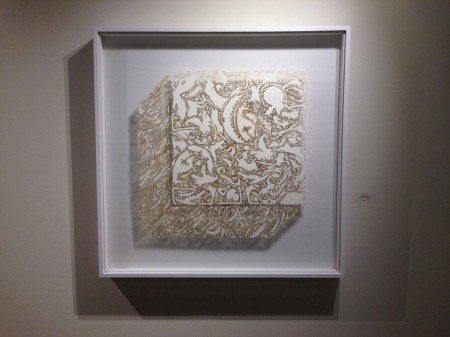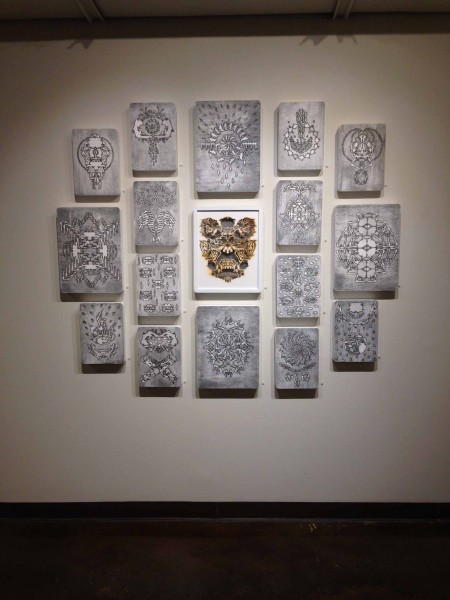Ryan O’Malley’s exhibition SHAPESHIFTER opened on April twelfth and is on display at Austin’s Flatbed Press and Gallery through May thirty-first. O’Malley is the printmaking professor at Texas A&M University, Corpus Christi. His imagery is complex and carries a stern longevity of idea. This idea has remained constant through the majority of O’Malley’s professional oeuvre and it reeks of modularity, sentimentality, and dedication.
Since 2004 O’Malley has been using the same series of 150 spray paint stenciled portraits as the basis for his. The portraits were initially begun during graduate school in tandem with his mezzotints. The portraits functioned as an acknowledgement of O’Malley’s support network, which, during his thesis, he admittedly neglected. Great work often means personal sacrifice. The portraits sweetly depict friends, family, students, and mentors. Members of the printmaking community include Greg Nanney, Nick Alley, Loyd Menard, and John Hancock. O’Malley’s mother is also among the cast of characters.
From this series of stencils O’Malley has generated woodcuts, lithographs, mezzotints, and serigraphs. He has pushed this series in every direction, begging the question of endurance as it relates to idea. The portraits have percolated, morphed, and evolved flowing through the synthesis and valence of every printmaking process. O’Malley has chopped and screwed his favorite faces into abstraction. Each process of printmaking has dictated differences in aesthetic personalities. This body of work is perhaps the most sophisticated and the most predicated on risk.
The foundation of the aesthetic make-up is forthrightly wrought of portraiture originally manifested through the most caveman of printmaking methods: The spray painted stencil. The stencils have been digitally augmented, vectored, and interfaced in a manner that extrapolates reality and reifies the meaning of friendship and identity through technology. The physical becomes prismatically metaphysical as it is synthesized and strangely transfigured through binary synthesis.
The potential modes of repetition through the digital matrix become infinite. This series is composed of laser cuts derived from the stencils, pushed toward the outer limits of abstraction. The act of arranging takes on a supernatural and compulsive personality rooted in the joy of organization, and the literal obfuscation of the act of abstracting. The vectored images are, importantly, virtually portable and could be shared endlessly across borders and context. Finally O’Malley has used the laser cuts to the absolute maximum. His context of process is of the greatest risk also. His medium of choice is the collagraph, which requires acute independence of technical troubleshooting given that its material possibilities upend the specificity of other print processes. The negative space of the laser cuts matrasses are used as independent elements of construction. Essentially the abstracted facial features that represent the shadowed areas of a face are cut free to positive the matrix. These pieces are what O’Malley has taken up as his collagraphic sword, arranging eyebrow fragments and their brethren into pattern-centric statements. The pieces of laser cut material are affixed to wooden backings and then inked and wiped like an intaglio plate with graphite ink. The prints are adhered to panels with rounded corners that lend a character to the object. These works become an installation in the gallery, arranged like a conglomerate around a centerpiece. That centerpiece is the matrix from which the pieces were initially cut. The genesis and ending become therein synonymous and self referential in a manner that is very gratifying.
O’Malley’s exhibition is utterly cohesive through its teleological unpacking of printmaking. Its conceptual anatomy is robust. At the same time the installation and aesthetics are so formally sound that the uninitiated can easily palate the iconography which is both totemic and abstract yet graphic and human.
–Jack Wood


